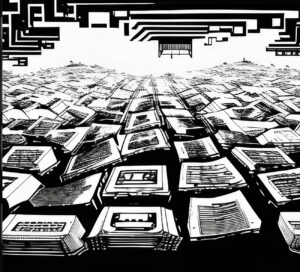Public Blockchains Are the New Economies of the Metaverse
An L1 platform is able to bootstrap its own format of a ‘nationwide economy’ through a flywheel between monetary speculation around its native token and real structure of applications and activities in its environment. When the native token cost goes up, it draws in more financial liquidity into the country, which funds more applications construction / development [in its area]. That, in turn, broadens the use cases and consequently grows on-chain “gross domestic products” which then bring in more users and producers, resulting in a larger holistic network. The need for native tokens increases as an outcome. Then, native token rates go up.
Such a system is comparable to how standard currencies work for physical, nation-state economies. Take firstly your requirement for using USD in practically every financial deal in the United States. When the US GDP grows (values and numbers of deals goes up), the pertinent need for USD increases, with all other things being equivalent / equal. This is one of the factors why, when an economy grows quick, its currency tends to concurrently grow in value versus others, disallowing foreign exchange interventions from the nation or nationwide [federal] government.
This is flux and movement is constant with the cost movements of Layer 1 chain tokens in current durations. As blockchain platform economies took off with the development of DeFi and NFT utility functions, the costs of Layer 1 native tokens have outshined general crypto markets. As of the end of 2021, 8 of the leading 15 crypto properties as per market cap were PoS (Proof of Stake), Layer 1 tokens. This is counting Ethereum, which is currently PoW but scheduled to be moving over to PoS. Yet 5 of them were not in the leading-15 list just two years back.
The PoS Layer 1 chains can then take advantage of their financial flywheel to initiate even more growth across their network, which is typically done by the releasing of brand-new [L1-specific] tokens. As the on-chain economy grows, need for the blockchain country’s native tokens develops in tandem, which itself enables the platform to problem more tokens as benefits to validators without affecting the token’s market rate. Those benefits in turn draw in more individuals into the community, powering future development. For example, Solana had grown its validator network by over 20 times in the past year and a half to over 1,300 active validator nodes as of end 2021.
No economy goes up in a straight line permanently. Levels of activities constantly ebb and circulation. In the real world, we call these organization cycles — as what economies go through during the well known ‘booms and busts. The federal governments of nation-states have long utilized direct policies (taxes and public costs) and fiscal policies (interest rate and cash supply), as tools to move and smooth out economic crises or expansions. Blockchain countries, likewise, have direct policies (transaction costs) and fiscal policies (staking yield, token issuance and burn) in their [digital] tool sets. And throughout many cases, one type of tool set may work better than the policies implemented and/or at the disposal of (real-world), federal governments.
When a real-world economy is deemed to be overheating, the associated nationwide federal government normally then attempts to tighten up its fiscal policies by raising tax rates and cutting public expenses. And when the economy is in crisis, it does the opposite.
In truth, though, such counter-cyclical policies are hardly ever carried out flawlessly or even well. This is due to restricted time horizons and varied, eclectic judgment mistakes by relevant decisionmakers. In the boom times, financial tightening is tough, since the real-world government(s) have greater profits readily available to invest. When the coffers are overrunning, few have the discipline or political perseverance to not consume more. Plus, there is a standing predisposition for the federal government to think that if the war chest is completely full today, it will also be tomorrow too, thereby under-preparing for the ultimate and inevitable slump. By the time economic crisis strikes, the financial buffer is too little to meaningfully promote the economy without taking on extra financial obligation.
In contrast, blockchain network fiscal policies are themselves, essentially always, preprogrammed in self-executing ‘smart’ contracts and functionalities. They are as such immune to overarching human discretion. Take Ethereum, as a thought example. Think of the gas prices paid to the Ethereum platform on each deal as a value-added tax or sales tax. The base charge is preprogrammed to change depending on the level of network usage. When the network rate goes over 50 percent (economic boom), the base cost increases by up to 12.5 percent. If the activity level goes under 50 percent (economic economic downturn), the base cost reduces. The counter-cyclicality of the on-chain financial policies are implemented by code. No people or entities, no matter how effective they are, can these execute a modification based on impulse.





